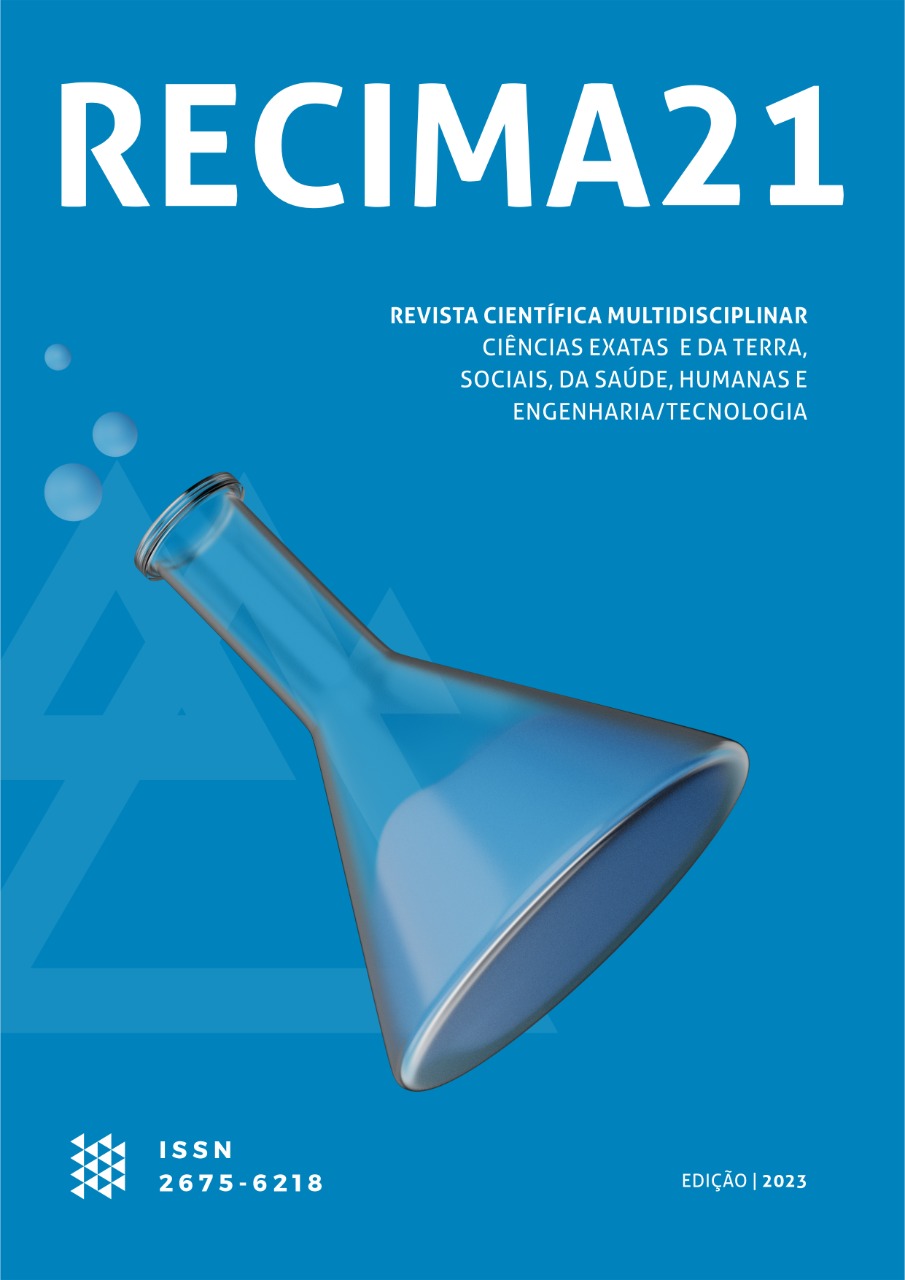ASSOCIATIONS BETWEEN DIETARY PATTERNS IN THE DEVELOPMENT OF HEAD AND NECK CANCER
DOI:
https://doi.org/10.47820/recima21.v4i11.4438Keywords:
Head and neck neoplasms, , Head and neck squamous cell carcinoma, Diet and dietary patterns.Abstract
Objective: To analyze the scientific evidence regarding dietary patterns and their influence on the risk of developing head and neck squamous cell carcinoma (HNSCC). Methods: this is an integrative review of the literature, guided by inclusion and exclusion criteria. The databases used were PubMed, SciELO and VHL. Articles describing dietary patterns, cohort studies, clinical trials associated with the development of squamous cell carcinoma, and exclusion criteria pertinent to the theme, such as other tumor types, and texts not related to cancer and diet, esophageal cancer, thyroid cancer, and cancers of the respiratory system, were included. Results: 7 articles were selected. Alcoholism and smoking are addictive factors and remain the main risk factors. However, other factors also influence the development of HNSCC, such as HPV infection, diet, exposure to carcinogens, oral hygiene, infectious agents, family history, low body mass index. The consumption of fruits, raw vegetables, fiber, vitamins and healthy lifestyle habits stands out as potential to promote the reduction of the onset of HNSCC. Dietary factors and lifestyle habits were strongly associated with the incidence of reduced onset of HNSCC. Conclusion: Dietary pattern modification is an important strategy for the development of new approaches to reduce the risk of developing this type of tumor.
Downloads
References
Sung H, Ferlay J, Siegel RL, Laversanne M, Soerjomataram I, Jemal A, et al. Global Cancer Statistics 2020: GLOBOCAN Estimates of Incidence and Mortality Worldwide for 36 Cancers in 185 Countries. CA Cancer J Clin [Internet]. maio de 2021 [citado 22 de abril de 2023];71(3):209–49.
Thomas SJ, Penfold CM, Waylen A, Ness AR. The changing aetiology of head and neck squamous cell cancer: A tale of three cancers? Clin Otolaryngol. 1o de agosto de 2018;43(4):999–1003.
Gormley M, Creaney G, Schache A, Ingarfield K, Conway DI. Reviewing the epidemiology of head and neck cancer: definitions, trends and risk factors. British Dental Journal | [Internet]. 2022 [citado 22 de abril de 2023];233(9):780–6.
Faria S de O, Howell D, Kulcsar MAV, Eluf-Neto J. Nutritional outcomes in head and neck cancer patients: is intensive nutritional care worth it? Cancer Treat Res Commun. 1 jan 2020;25:1–6.
Li WQ, Park Y, Wu JW, Goldstein AM, Taylor PR, Hollenbeck AR, et al. Index-based dietary patterns and risk of head and neck cancer in a large prospective study 1-4. Am J Clin Nutr [Internet]. 2014 [citado 3 jun 2023];99:559–66.
Mota LP, Carvalho MRM de A, Carvalho Neto AL de, Ferreira FADA, Poty JAC, Pompeu JGF, et al. Neoplasia de cabeça e pescoço: Principais causas e tratamentos. Research, Society and Development. 16 maio 2021;10(5):1–11.
Siddiqui IA, Sanna V, Ahmad N, Sechi M, Mukhtar H. Resveratrol nanoformulation for cancer prevention and therapy. Ann N Y Acad Sci. 2015;1348(1):20–31.
Ruiz TM, Bertelli-Pavarino É, Maniglia VJ, Ruback JM, Bertollo-Golini ME. Epidemiologia e biomarcadores em câncer de cabeça e pescoço. Arq. Ciênc. Saúde. 2006;1–5.
Rodríguez-Molinero J, Blanca del Carmen Migueláñez-Medrán, Cristina Puente-Gutiérrez, Esther Delgado-Somolinos, Carmen Martín Carreras-Presas, Javier Fernández-Farhall, et al. Association between oral cancer and diet: An update. Nutrients. 2021;13(4):2–15.
McClain KM, Bradshaw PT, Khankari NK, Gammon MD, Olshan AF. Fish/shellfish intake and the risk of head and neck cancer. European Journal of Cancer Prevention. 28 mar 2019;28(2):1–16.
Huang T, Ploner A, Chang ET, Liu Q, Cai Y, Zhang Z, et al. Dietary patterns and risk of nasopharyngeal carcinoma: a population-based case-control study in southern China. American Journal of Clinical Nutrition. 1 ago. 2021;114(2):462–71.
Saraiya V, Bradshaw P, Meyer K, Gammon M, Slade G, Brennan P, et al. The association between diet quality and cancer incidence of the head and neck. Cancer Causes and Control. 1 fev 2020;31(2):1–10.
Galvão DPOP, Peres SV, Salaroli LB, Cattafesta M, Vasconcelos De Podestá JR, Ventorin von Zeidler SL, et al. Consumption of minimally processed foods as protective factors in the genesis of squamous cell carcinoma of the head and neck in Brazil. PLoS One. 25 jul 2019;14(7):1–19.
Saka-Herrán C, Pereira-Riveros T, Jané-Salas E, López-López J. Association between the Mediterranean Diet and Vitamin C and the Risk of Head and Neck Cancer. Nutrients. 23 jun. 2023;15(13):1–12.
Argirion I, Arthur AE, Zarins KR, Bellile E, Crowder SL, Amlani L, et al. Pretreatment Dietary Patterns, Serum Carotenoids and Tocopherols Influence Tumor Immune Response in Head and Neck Squamous Cell Carcinoma. Nutr Cancer. 2021;73(11–12):1–23.
Razavi SM, Askari G, Zahiri Z, Heidari Z, Keshani F. A comparative analysis of dominant dietary patterns in patients with and without oral squamous cell carcinoma. Adv Biomed Res. 1 jan 2023;12(1):4.
Lucenteforte E, Garavello W, Bosetti C, La Vecchia C. Dietary factors and oral and pharyngeal cancer risk. Oral Oncol. jun 2009;45(6):461–7.
Soares SA, Augusto G, Polignano C. Incidência do carcinoma de células escamosas da cavidade oral em jovens. Cadernos de Odontologia. 2020;01:1–12.
Pavia M, Pileggi C, Nobile CG, Angelillo IF. Association between fruit and vegetable consumption and oral cancer: a meta-analysis of observational studies 1,2. American Society for Nutrition. 2006;83:1126–34.
Cousins RJ. Nutritional regulation of gene expression. American Journal of Medicine [Internet]. 25 jan 1999 [citado 12 de agosto de 2023];106(1 A):20–3.
Edefonti V, Hashibe M, Parpinel M, Turati F, Serraino D, Matsuo K, et al. Natural vitamin C intake and the risk of head and neck cancer: A pooled analysis in the International Head and Neck Cancer Epidemiology Consortium. Int J Cancer. 15 jul 2015;137(2):448–62.
Downloads
Published
License
Copyright (c) 2023 RECIMA21 - Revista Científica Multidisciplinar - ISSN 2675-6218

This work is licensed under a Creative Commons Attribution 4.0 International License.
Os direitos autorais dos artigos/resenhas/TCCs publicados pertecem à revista RECIMA21, e seguem o padrão Creative Commons (CC BY 4.0), permitindo a cópia ou reprodução, desde que cite a fonte e respeite os direitos dos autores e contenham menção aos mesmos nos créditos. Toda e qualquer obra publicada na revista, seu conteúdo é de responsabilidade dos autores, cabendo a RECIMA21 apenas ser o veículo de divulgação, seguindo os padrões nacionais e internacionais de publicação.













